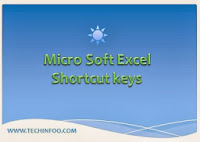Table of Contents:
Share This :
- Navigating in Worksheets and Selecting Cells
- Format Cells
- Function keys in Excel 2007
- CTRL Combinations in Excel 2007
- Smart-Art Graphics: Work with shapes
- Smart-Art Graphics : Work with Text
- Microsoft Clip Organizer main
- Work with the Excel Ribbon

| F1 | Displays the Microsoft Office Excel Help task pane. |
| Ctrl+f1 | Displays or hides the Ribbon, a component of the Microsoft Office Fluent user interface. |
| Alt+f1 | Creates a chart of the data in the current range. |
| Alt+shift+f1 | Inserts a new worksheet. |
| F2 | Edits the active cell and positions the insertion point at the end of the cell contents. It also moves the insertion point into the Formula Bar when editing in a cell is turned off. |
| Shift+f2 | Adds or edits a cell comment. |
| Ctrl+f2 | Displays the Print Preview window. |
| F3 | Displays the Paste Name dialog box. |
| Ctrl+f3 | Display the Name Manager, create new names. |
| Shift+f3 | Displays the Insert Function dialog box. |
| F4 | Repeats the last command or action, if possible. |
| Ctrl+f4 | Closes the selected workbook window. |
| F5 | Displays the Go To dialog box. |
| Ctrl+f5 | Restores the window size of the selected workbook window. |
| F6 | Switches between the worksheet, Ribbon, task pane, and Zoom controls. In a worksheet that has been split (View menu, Manage This Window, Freeze Panes, Split Window command), F6 includes the split panes when switching between panes and the Ribbon area. |
| Shift+f6 | Switches between the worksheet, Zoom controls, task pane, and Ribbon. |
| Ctrl+f6 | Switches to the next workbook window when more than one workbook window is open. |
| F7 | Displays the Spelling dialog box to check spelling in the active worksheet or selected range. |
| Ctrl+f7 | Performs the Move command on the workbook window when it is not maximized. Use the arrow keys to move the window, and when finished press ENTER, or ESC to cancel. |
| F8 | Turns extend mode on or off. In extend mode, Extended Selection appears in the status line, and the arrow keys extend the selection. |
| Shift+f8 | Enables you to add a nonadjacent cell or range to a selection of cells by using the arrow keys. |
| Ctrl+f8 | Performs the Size command (on the Control menu for the workbook window) when a workbook is not maximized. |
| Alt+f8 | Displays the Macro dialog box to create, run, edit, or delete a macro. |
| F9 | Calculates all worksheets in all open workbooks. |
| Shift+f9 | Calculates the active worksheet. |
| Ctrl+alt+f9 | calculates all worksheets in all open workbooks, regardless of whether they have changed since the last calculation. |
| Ctrl+alt+shift+f9 | Rechecks dependent formulas, and then calculates all cells in all open workbooks, including cells not marked as needing to be calculated. |
| Ctrl+f9 | Minimizes a workbook window to an icon. |
| F10 | Turns key tips on or off. |
| Shift+f10 | Displays the shortcut menu for a selected item. |
| Alt+shift+f10 | Displays the menu or message for a smart tag. If more than one smart tag is present, it switches to the next smart tag and displays its menu or message. |
| Ctrl+f10 | Maximizes or restores the selected workbook window. |
| F11 | Creates a chart of the data in the current range. |
| Shift+f11 | Inserts a new worksheet. |
| Alt+f11 | Opens the Microsoft Visual Basic Editor, in which you can create a macro by using Visual Basic for Applications (VBA). |
| F12 | Displays the Save As dialog box. |
0 comments:
Post a Comment